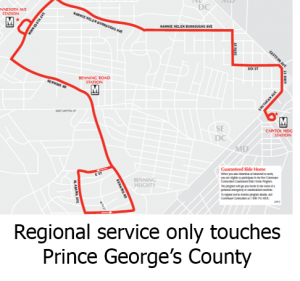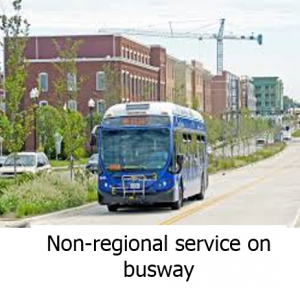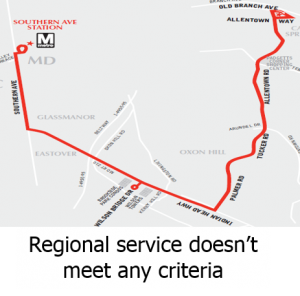Does Metrobus Need a Refresh?
Metrobus has a strong identity as a regional transit provider, but as the region has grown it hasn’t kept up with changing development patterns. Does the regional role of Metrobus need to be rethought?
A previous post described the historical context of Metrobus as a regional bus service provider, as well as the Metrobus regional service criteria developed by a regional “Blue Ribbon Mobility Panel” in 1997. What has happened to the Metrobus regional service since the 1998 Board action? Does today’s regional service still meet the original criteria? Metro’s planners recently conducted an assessment to address these questions.
Majority of “regional” Metrobus service performs well
Overall, Metrobus regional lines provide higher levels of service and achieve higher cost efficiency than non-regional lines. Currently Metrobus operates 106 regional lines and 55 non-regional lines The overall higher ridership of the regional lines resulted in an average operating cost of $3.50 per passenger trip, lower than the non-regional service at $4.50.
Regional Definitions are not Keeping up with Demand and Service Function
Changing demand and route-level decisions over the past 17 years have resulted in some regional services that actually function and perform as non-regional services. We came up with measurable scores for the routes and lines and then compared them with the 1997 criteria.
- Among the 106 regional lines:
- 29 regional lines (27%) operate in only one jurisdiction;
- 50 regional lines (47%) no longer meet the cost efficiency criterion; and
- 9 regional lines (8%) do not meet at least two of the regional service criteria.
- A number of non-regional line appeared to meet the regional service criteria. For example, 42 out of the 55 non-regional lines meet at least two criteria for regional service – serving at least one RAC and traveling on arterial roads with more than 50% of the route.
Additionally, the current definition has created inconsistencies across our region. For example, while Virginia has many compact (PDF) jurisdictions, Maryland has only two, Montgomery and Prince George’s Counties. So the chances of a route crossing jurisdictional lines, and being classified as “regional,” is higher in Virginia than in Maryland irrespective of its function. There are also regional routes that cross jurisdictional lines solely to access a Metrorail station located in the neighboring jurisdiction, while there are non-regional routes that function regionally. The latter includes Metroway, the region’s first bus rapid transit line, which is currently classified as non-regional.
Based on the network analysis, the 1997 regional service criteria appeared outdated due to demand and service changes over the years. Staff believes it may be time to explore an update to the criteria to better reflect Metrobus’ service performance, approach a “business model-mindset” to bus operations, and better reflect Metro’s intended role in the region.
Ed. Note, 9/2/2015: Table above updated to reflect units of operating cost and subsidy in millions.





Metrobus needs to be rethought on a larger scale than just looking at a handful of lines a couple times a year, or the fuss over whether to classify this or that route as “regional” or not. For example, despite all the development on both sides of the Wilson Bridge (e.g. Carlyle, National Harbor) and the enormous amount of SOV traffic on it, there is no reasonable transit between northern VA and PG County. That’s just one example; there are many others. The service hasn’t kept up with regional changes.
Having trouble understanding the table…can you add units to the labels?
Montgomery County pays a large share of the cost of Ride-On, while the state pays the entire cost of regional Metrobus service in the county. Since 1998, many Ride-On routes have gained ridership and are likely to meet criteria for regional service. Some (e.g., on MD 355) are even under consideration for upgrading to BRT.
It would be highly inappropriate to convert regional bus routes into local routes without also converting local routes into regional routes where appropriate. Moreover, doing so would have the effect of taking costs out of the state budget and dumping them on the county.
Mr. Ross above hits the nail on the head — the issue with the “regionality” of a bus line comes down to who funds it, which is non-trivial.
I’m going to assume (really hope) that the intent of the original 1998 board action was to have the following policy (since it seems fair):
1) “Regional” bus service is that which serves the needs of moving riders who could potentially be from anywhere in the region, and thus should be funded in a similar fashion as Metrorail.
– This is probably the service where WMATA has the strongest mandate as the provider.
2) “Non-regional” bus service is that which serves the needs of moving riders from a specific local jurisdiction only, and thus should be funded by the local jurisdiction.
– IIRC, in 1998 those routes were probably still largely run by WMATA, as there weren’t many local bus providers like ART or Ride-On. That’s now changed, and perhaps it makes more sense to devolve responsibility for those to the local providers.
3) Perhaps its now worth recognizing a third group, a “sub-regional” service which serves the needs of riders from a few contiguous jurisdictions (say, Arlington and Alexandria) within the region, but is of little value to riders from any other jurisdiction.
– An example of this might be the future Purple Line, which serves two jurisdictions and is largely being funded by them (and their state).
Considering the above, keeping the concept of “regionality” of service is important in order to have equitable funding.
Of course, deciding the criteria for how regional a service is is the hard part. Maybe the best way to do so would be to make the criteria fuzzier and allow some discretion on these designations to make sure they are serving the purpose intended and can be reviewed / altered as needed.
I’m thinking something like —
“Regional” service does at least one of the following:
– Provides service along the length of a travel corridor passing through at least 3 jurisdictions
– Connects riders in jurisdictions A and B to an RAC in jurisdiction C
– Connects two RACs, one in jurisdiction A the other in jurisdiction B in a fashion that allows riders from A to reach the RAC in B easily, and allows riders from B to reach the RAC in A easily.
– Connects an RAC to a Metrorail station regardless of jurisdiction crossings, as it extends Metrorail’s reach to non-adjacent RACs.
– Provides an alternative to Metrorail in a single capacity-constrained corridor within one (or more) jurisdiction(s), as this frees up rail capacity that would otherwise be taken up by riders from that corridor.
“Subregional” service does at least one of the following:
– Provides service in a travel corridor that passes through at least 2 jurisdictions, but perhaps not the entire length of the corridor.
– Provides access for riders from at least 2 jurisdictions to a single activity center within one of those 2 jurisdictions.
– Connects an RAC to a major bus transit center that can be reached by riders from at least 2 jurisdictions, but doesn’t connect to Metrorail.
“Non-regional” service would be remaining routes, which likely only includes:
– Service that connects riders from a single jurisdiction to an RAC and/or Metrorail station, but doesn’t extend the reach of Metrorail.
– Service that connects riders from a single jurisdiction to a major bus transit center.
Given that routes can be classified as such technocratically (and reclassified as RACs, Metrorail, etc. evolve), then the funding decisions become easier. “Regional” service is funded similarly to Metrorail and provided by Metrobus, “Subregional” service is funded primarily by the jurisdictions it serves (and perhaps the containing State) and provided by whomever they choose (perhaps Metrobus), and “non-regional” services is funded primarily by the single jurisdiction it serves and is encouraged to be provided by the existing local provider.